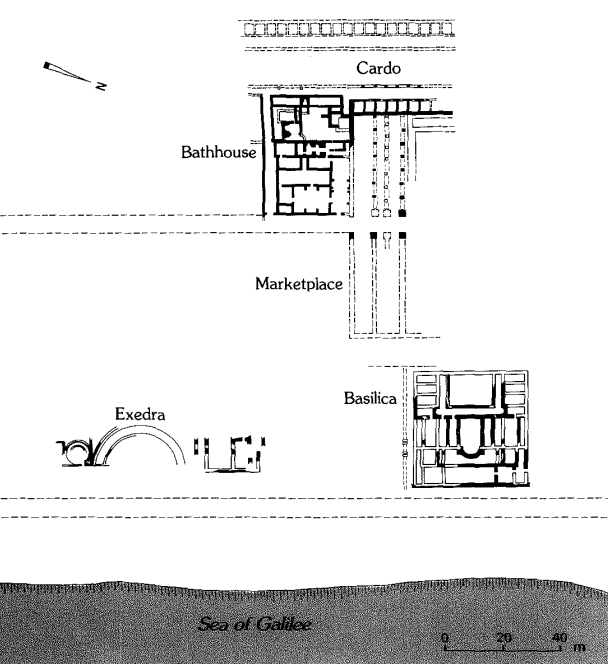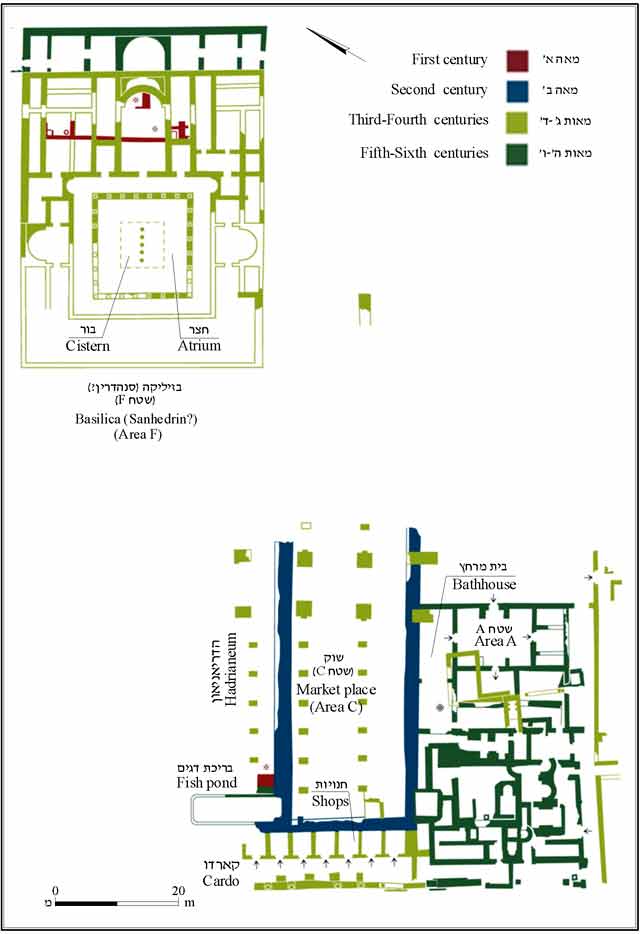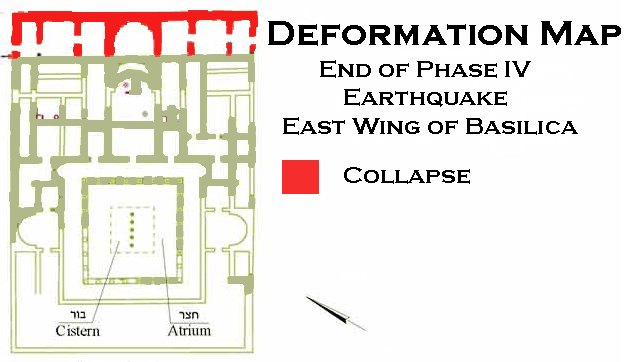Tiberias - Basilica
 Tiberias Basilica
Tiberias Basilicaclick on image to explore this site on a new tab in govmap.gov.il
Tiberias - Introduction Webpage
- from Tiberias - Introduction - click link to open new tab
Maps, Aerial Views, and Plans
Normal Size
- Fig. 4 Map of all Tiberias
sites studied by Ferrario et al (2020) (Basilica is middle right)

 Figure 4: Map of ancient Tiberias (modified after Hirschfeld & Gutfeld, 2008) with indication of the inferred lineament and trench position.
Figure 4: Map of ancient Tiberias (modified after Hirschfeld & Gutfeld, 2008) with indication of the inferred lineament and trench position.
Ferrario et al (2015) - City center plan of
Tiberias from Stern et al (1993 v.4)

 Plan of the main buildings in the city center. Plan of the main buildings in the city center
Plan of the main buildings in the city center. Plan of the main buildings in the city center
Stern et al (1993 v.4) - Tiberias Basilica in Google Earth
- Tiberias Basilica on govmap.gov.il
- Fig. 1 Plan of church on
the remains in the center of Tiberias from Hirschfeld and Meir (2004)

 Figure 1
Figure 1
The remains in the center of Tiberias, plan.
Hirschfeld and Meir (2004)
Magnified
- Fig. 1 Plan of church on
the remains in the center of Tiberias from Hirschfeld and Meir (2004)

 Figure 1
Figure 1
The remains in the center of Tiberias, plan.
Hirschfeld and Meir (2004)
Phasing
All of Tiberias
| Stratum | Period | Date | Notes |
|---|---|---|---|
| I | Late Fatimid | 11th century CE | construction above the collapse caused by an earthquake (in 1033 CE?) |
| II | Early Fatimid | 9th - 10th centuries CE | continued use of the street with shops. |
| III | Abbasid | 8th - 9th centuries CE | a row of shops, the basilica building was renovated. |
| IV | Byzantine–Umayyad | 5th - 7th centuries CE | the eastern wing was added to the basilica building; the paved street; destruction was caused by the earthquake in 749 CE. |
| V | Late Roman | 4th century CE | construction of the basilica complex, as well as the city’s institutions, i. e., the bathhouse and the covered market place. |
| VI | Roman | 2nd - 3rd centuries CE | establishment of the Hadrianeum in the second century CE (temple dedicated to Hadrian that was never completed) and industrial installations; the paving of the cardo and the city’s infrastructure. |
| VII | Early Roman | 1st century CE | founding of Tiberias, construction of the palace with the marble floor on the shore of the Sea of Galilee, opus sectile, fresco. |
| VIII | Hellenistic | 1st - 2nd centuries BCE | fragments of typical pottery vessels (fish plates, Megarian bowls). |
End of Phase IV earthquake - mid 8th century CE ?
Plans
Normal Size
- Fig. 1 Plan of church on
the remains in the center of Tiberias from Hirschfeld and Meir (2004)

 Figure 1
Figure 1
The remains in the center of Tiberias, plan.
Hirschfeld and Meir (2004)
Magnified
- Fig. 1 Plan of church on
the remains in the center of Tiberias from Hirschfeld and Meir (2004)

 Figure 1
Figure 1
The remains in the center of Tiberias, plan.
Hirschfeld and Meir (2004)
Hirschfeld and Meir (2004) discussed Stratum IV as follows:
Stratum IV (sixth century CE). Another, eastern wing, was apparently constructed east of the apse’s outer wall during the Byzantine period. It was accessed by way of an entrance adorned with magnificent doorjambs, in situ, whose lower parts were dressed to resemble half Attic bases (Fig. 5). The eastern wing was probably destroyed in the earthquake of 749 CE. The collapse inside the rooms contained numerous roof tiles, some of them almost complete and a large quantity of plaster and fragments of a plain mosaic floor. A noteworthy find from this destruction was a large bronze goblet-like mortar and a pestle that was found nearby, in the collapse of one of the rooms (Fig. 6). In all likelihood, these were not simple kitchen utensils, although their usage is unclear.
End of Phase II earthquake - 11th century CE
Hirschfeld and Meir (2004) noted that Stratum I was
built above the collapse [of Stratum II] caused by an earthquake.
Stratum I was dated to the 11th century CE while stratum II was dated to the 9th-10th centuries CE.
End of Phase IV earthquake - mid 8th century CE ?
| Damage Type | Location | Image(s) | Comments |
|---|---|---|---|
| Collapsed walls and structure | Eastern wing
 Figure 1
Figure 1The remains in the center of Tiberias, plan. Hirschfeld and Meir (2004) |
|
|
| 2nd storey and roof collapse | Eastern wing
 Figure 1
Figure 1The remains in the center of Tiberias, plan. Hirschfeld and Meir (2004) |
|
End of Phase II earthquake - 11th century CE
| Damage Type | Location | Image(s) | Comments |
|---|---|---|---|
| Collapsed structure | Entire Building ?
 Figure 1
Figure 1The remains in the center of Tiberias, plan. Hirschfeld and Meir (2004) |
|
End of Phase IV earthquake - mid 8th century CE ?
- Modified by JW from Fig. 1 of Hirschfeld and Meir (2004)
 Deformation Map
Deformation MapModified by JW from Fig. 1 of Hirschfeld and Meir (2004)
End of Phase IV earthquake - mid 8th century CE ?
- Earthquake Archeological Effects chart
of Rodríguez-Pascua et al (2013: 221-224)

 Earthquake Archeological Effects (EAE)
Earthquake Archeological Effects (EAE)
Rodríguez-Pascua et al (2013: 221-224)
| Damage Type | Location | Image(s) | Comments | Intensity |
|---|---|---|---|---|
| Collapsed walls and structure | Eastern wing
 Figure 1
Figure 1The remains in the center of Tiberias, plan. Hirschfeld and Meir (2004) |
|
VIII+ | |
| 2nd storey and roof collapse | Eastern wing
 Figure 1
Figure 1The remains in the center of Tiberias, plan. Hirschfeld and Meir (2004) |
|
VIII+ |
End of Phase II earthquake - 11th century CE
- Earthquake Archeological Effects chart
of Rodríguez-Pascua et al (2013: 221-224)

 Earthquake Archeological Effects (EAE)
Earthquake Archeological Effects (EAE)
Rodríguez-Pascua et al (2013: 221-224)
| Damage Type | Location | Image(s) | Comments | Intensity |
|---|---|---|---|---|
| Collapsed structure | Entire Building ?
 Figure 1
Figure 1The remains in the center of Tiberias, plan. Hirschfeld and Meir (2004) |
|
VIII+ |
References
